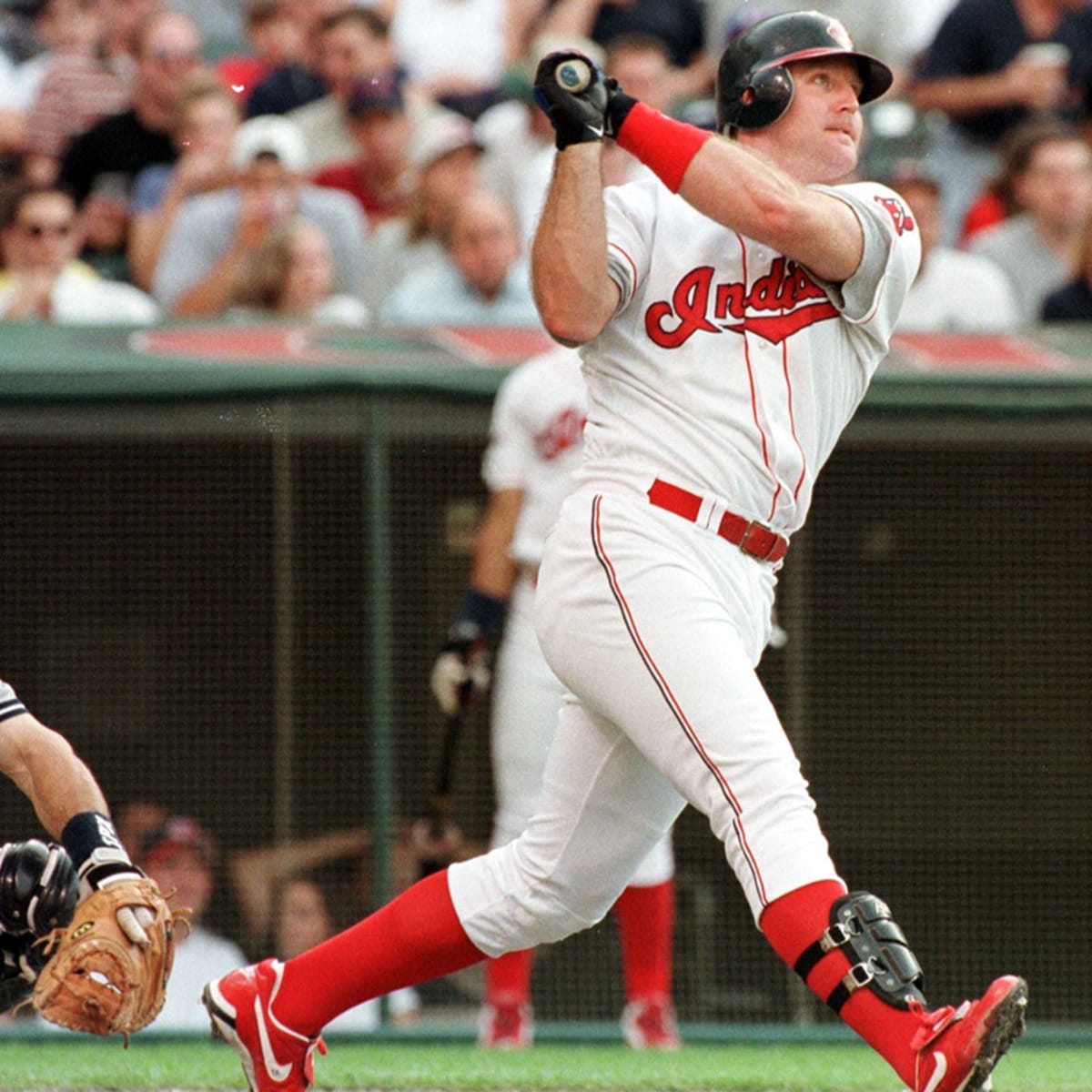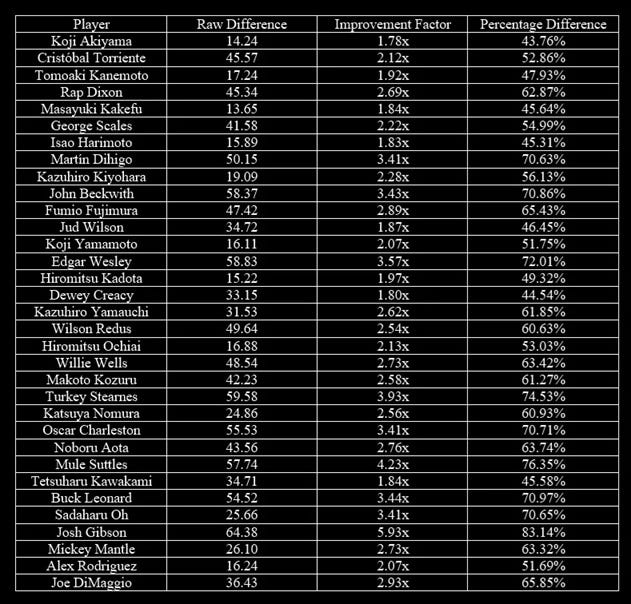This project aims to determine the greatest home run hitter of all time by comparing each slugger’s statistics to the average of their era using three formulas. The final adjusted stats will then be used to compare them head-to-head with other all-time greats.
Jim Thome will be the next legendary MLB slugger examined in this study. For a detailed biography of Thome, please click here. Before fully analyzing Thome’s AB/HR figures using our formulas and methodology, it’s important to review his key hitting statistics to understand the extent of his offensive impact at the plate:
Total Bases: 4,667
Times On Base: 4,144
Extra Base Hits: 1,089
Homeruns: 612
On Base + Slugging: .956
Slugging Percentage: .554
On Base Percentage: .402
Batting Average: .276
Now that we’ve reviewed Thome’s key hitting statistics, it’s important to highlight his career accomplishments to fully appreciate his overall talent as a baseball player:
Hall of Fame Member: Class of 2018
AL Silver Slugger (1996)
2006 AL Comeback Player of the Year
3x AL Walks Leader (1997, 1999, & 2002)
AL OPS Leader (2002)
AL Slugging Percentage Leader (2002)
100 Runs Scored Seasons: 8 (1996, 1997, 1999-2003, & 2006)
NL Home Runs Leader (2003)
50-HR Seasons: 1 (2002)
40-HR Seasons: 6 (1997, 2001-2004, & 2006)
30-HR Seasons: 12 (1996-2004 & 2006-2008)
20-HR Seasons: 16 (1994-2004 & 2006-2010)
Now that his career accomplishments are clear, let's examine Jim Thome's rankings on MLB leaderboards in key hitting statistics:
1995: #3 (.438)
1996: #7 (.450)
1997: #8 (.423)
1998: #9 (.413)
2002: #4 (.445)
2001: #7 (.624)
2002: #2 (.677)
2006: #8 (.598)
1995: #8 (.996)
1996: #5 (1.062)
1997: #10 (1.001)
1998: #7 (.997)
2001: #8 (1.040)
2002: #2 (1.122)
2006: #7 (1.014)
1996: #9 (122)
1997: #8 (40)
2001: #5 (49)
2002: #2 (52)
2003: #1 (47)
2004: #6 (42)
2006: #7 (42)
2007: #7 (35)
2003: #8 (80)
1995: #7 (97)
1996: #6 (123)
1997: #4 (120)
1999: #3 (127)
2000: #3 (118)
2001: #4 (111)
2002: #4 (122)
2003: #3 (111)
2004: #8 (104)
2006: #8 (107)
2001: #10 (143)
2002: #2 (155)
2003: #8 (135)
1996: #10 (286)
1997: #4 (12.40)
2001: #4 (10.73)
2002: #2 (9.23)
2003: #4 (12.30)
2004: #3 (12.10)
2006: #5 (11.67)
2007: #5 (12.34)
2008: #9 (14.79)
Jim Thome’s best season was 2002, with 7 MLB hitting leaderboard appearances, the most of any year in his career. He ranked:
#2 in Slugging Percentage (.677)
#2 in OPS (1.122)
#2 in Home Runs (52)
#2 in Runs Created (155)
#2 in AB/HR (9.23)
#4 in On Base Percentage (.445)
#4 in Walks (122)
This exceptional performance showcases Thome’s elite power, plate discipline, and overall offensive impact marking 2002 as the peak of his career.
Now that we have a deeper appreciation for Jim Thome as a hitter, we can move forward with our unique career AB/HR analysis. According to Baseball Reference, Thome’s official statistics reveal a total of 612 home runs over 8,422 at-bats resulting in an average of at-bats per home run 13.76 (AB/HR).
Jim Thome spent most of his career in the American League (AL), playing from 1991 to 2002, 2006 to 2008, and again from 2010-2011. He played exclusively in the National League (NL) during the 2003 to 2005 seasons.
Thome played in both the AL and NL in the 2009 & 2012 seasons. Since the designated hitter (DH) rule applied exclusively to the AL at the time, hitters are compared within their respective leagues. To calculate the overall 2009/2012 league averages for Thome, we combined and averaged out the figures from both leagues.
When aggregating the statistics from each of the seasons Thome competed in, the league totals include 1,725,993 at-bats and 52,422 home runs, resulting in an average of 32.92 at-bats per home run (AB/HR).
With this data, we can evaluate how Thome’s performance compared to the average AL/NL hitter of his era.
Raw Difference: -19.16
Formula: League Average – Player Career AverageImprovement Factor: 2.39x
Formula: League Average / Player Career AveragePercentage Difference: 58.20%
Formula: (League Average – Player Career Average) / League Average × 100%
AB/HR
This metric indicates that Thome hit a home run, on average, every 13.76 at-bats over his career. A lower AB/HR ratio is better, as it means a player hits home runs more frequently. The aggregated league average during Thome’s career (1991–2012, accounting for AL and NL seasons) was 32.92 at-bats per home run.
Raw Difference
Thome’s AB/HR is 19.16 at-bats lower than the league average, indicating he hit home runs far more frequently than the average hitter. This raw difference highlights the magnitude of his superiority in home run frequency.
Improvement Factor
Thome’s AB/HR is 2.39 times better (lower) than the league average. This means Thome hit home runs at a rate nearly 2.4 times more efficient than the average hitter in his era.
Percentage Difference
Thome’s AB/HR represents a 58.20% improvement over the league average. This percentage underscores that his home run-hitting ability was significantly better than the norm, reducing the number of at-bats needed per home run by over half.
Thome’s AB/HR of 13.76 places him among the best power hitters of his era. The 2.39x improvement factor and 58.20% percentage difference demonstrate that Thome was not just above average but dramatically better than the typical hitter. He required less than half the at-bats of an average player to hit a home run. With 612 career home runs, Thome ranks among MLB’s all-time leaders. His AB/HR ratio supports his reputation as a prolific slugger, and his performance stands out even in an era with inflated offensive stats.
In our initial case study, we analyzed the careers of prominent Japanese and Negro League sluggers, alongside MLB greats Mickey Mantle, Alex Rodriguez, and Joe DiMaggio for comparison.
Now, let's compare Thome’s career statistics against these baseball legends to gain a clearer perspective on how he stacks up.
Jim Thome’s statistics closely mirror those of Wilson Redus (-49.64/2.54x/60.63%). Redus hit a total of 86 home runs over 2,772 at-bats resulting in an average of 32.23 at-bats per home run (AB/HR). When aggregating the statistics from each of the seasons Redus competed in, the league totals include 211,542 at-bats and 2,584 home runs, resulting in an average of 81.87 at-bats per home run (AB/HR).
Among the league leaders in home runs during the 1990s, we have analyzed the power-hitting careers of the following players:
Vladimir Guerrero (-14.40/1.79x/44.23%)
Vinny Castilla (-13.04/1.61x/37.95%)
Tino Martinez (-12.08/1.58x/36.54%)
Shawn Green (-10.13/1.47x/31.94%)
Sammy Sosa (-20.59/2.42x/58.73%)
Ryne Sandberg (-13.89/1.47x/31.84%)
Ron Gant (-16.41/1.82x/44.95%)
Rob Deer (-22.42/2.33x/57.06%)
Rafael Palmeiro (-15.95/1.87x/46.43%)
Mo Vaughn (-16.09/1.95x/48.82%)
Mike Piazza (-17.68/2.09x/52.20%)
Mickey Tettleton (-16.65/1.87x/46.47%)
Matt Williams (-17.62/1.95x/48.75%)
Mark McGwire (-23.70/3.23x/69.08%)
Manny Ramirez (-17.29/2.16x/53.80%)
Larry Walker (-17.35/1.96x/49.04%)
Kevin Mitchell (-21.80/2.23x/55.23%)
Ken Griffey Jr. (-17.84/2.15x/53.41%)
Juan Gonzalez (-18.24/2.21x/54.69%)
Jose Canseco (-18.87/2.24x/55.27%)
Joe Carter (-14.79/1.70x/41.01%)
Jim Thome ranks 3rd among 22 elite MLB hitters, with a 58.20% percentage difference, -19.16 raw difference, and 2.39x improvement factor, trailing only Mark McGwire (69.08%) and Sammy Sosa (58.73%). Thome’s stats place him above legends like Ken Griffey Jr., Manny Ramirez, Juan Gonzalez, Jose Canseco, and Mike Piazza; showcasing his dominance as a power hitter in a high-octane era.
If you find this content valuable and would like to support the ongoing studies and articles, your contributions via CashApp are truly appreciated.
Your support helps fund the tools, research, and time dedicated to these projects. Every contribution, no matter the size, plays an important role in keeping this work going.
If you're unable to contribute financially, sharing this article on your social media (X, Facebook, etc.), emailing it to a friend, or texting the link to a fellow baseball fan is just as valuable.
Thank you for your support!











He was the center piece imo. Not Belle although we could make a case. Omar and Lofton were key pieces but Thome was the engine.
Thome imo is the most underrated member of the 600 club. Shades of Eddie Mathews. Nothing flashy. Played an average 1st base. Needed a card to tell me he played 3rd base lol. Quiet, efficient, powerful stroke. Paul Bunyan type of folk hero in the modern era.